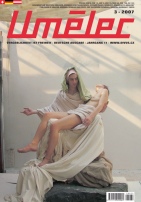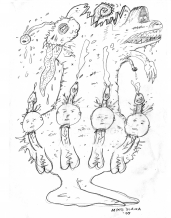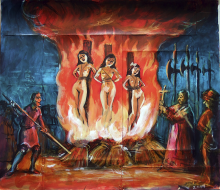| Umělec magazine 2007/3 >> THE BREAD FACTORY AND THE CONTEMPORARY ART GALLERY | List of all editions. | ||||||||||||
|
|||||||||||||
THE BREAD FACTORY AND THE CONTEMPORARY ART GALLERYUmělec magazine 2007/301.03.2007 William Hollister | baking | en cs de es |
|||||||||||||
|
A few years ago, Piotr Mankiewicz wished to build a “museum of bread,” using an abandoned bakery in the Polish post-industrial city of Bytom. But that town’s government thought that the idea was stupid, and did not give permission for the building’s use. So Mankiewicz went to the nearby village of Radzionkow to fulfill his dream. Today, a large billboard greets visitors near the Katowice airport advertising his museum as one of the most alluring attractions in Polish Silesia. Indeed, families flock from all over the country to celebrate the art of bread making—with workshops and freshly baked exhibitions regularly. Now the otherwise small town of Radzionkow is enjoying a small economic revival as a result. Meanwhile, the house, that Mankiewicz had hoped to use in Bytom, has been moldering abandoned for a decade. As an eyesore, there is speculation that the structure might be torn down. After an earthquake had leveled the Macedonian capital, Skopje, in 1963, an array of international architects were assembled to rebuild the Balkan city. Poland initiated a design competition for a new museum of contemporary art. Unfortunately, by some accounts, the Polish awarded the job to the wrong architects. At the Kronika gallery in Bytom this year, two artists from Macedonia, Yane Calovski and Hristina Ivanovska, were invited by curator Sebastian Cichocki with a project to assemble an exhibition exploring what might have happened in Skopje if, 45 years ago, a different museum proposal had won that Polish competition—the proposal by Oscar Hansen. In the current era, the idea of the city museum, or gallery is undergoing constant reassessment as to how to be flexible with the evolving options offered by contemporary art. While entirely unrelated, there seems to be as much that contemporary art galleries can learn from Hansen’s “lost museum” as there is from Mankiewicz’s museum of bread.
ORPHANS OF CULTURE, LEGENDS AND HEROES Calovski and Ivanosvka’s resulting project is a series of simple posters constructed on a hexagonal pattern echoing Hansen’s honeycomb museum design concept. The architect had proposed a very flexible space that would have been malleable, with giant umbrella-like platforms that could be folded and hidden underground. “The design called for a transformable exhibition space, able to fold completely and then unfold into various combinations, with hexagonal elements lifted by hydraulicallypowered rotating telescopes. The structure would transform in horizontal and vertical dimensions at the same time,” as Hansen himself once explained. This is in stark contrast to the very conservative modern museum that currently sits on a hill overlooking Skopje. In reflecting on that concept the artists considered how different artists might have interacted with Hansen’s spaces, over the course of the past few decades. The exposition at Bytom’s consists simply of a series posters of imagined exhibitions that could have been shown at that Skopje museum posters of artists including creating an imagined set of exhibitions spanning the past several decades, beginning in 1968 with “the last solo exhibition of Dusan Percinkov who will stop painting by the mid 70s.” In 1973, for example, Cuban-American artist Ana Mendieta was billed for a performance entitled “People Looking at Blood, (Rape Scene), which in fact had been a performance in the artists’ Iowa apartment in 1973. The Brooklyn-born Paul Thek’s 1974 show was entitled “A Life in Which There Seems to be No Winning,” and again in 1987 with “Susan lecturing on Neitzsche” as the artist’s reflection on Susan Sontag. Ad Rainhardt’s 1996 show was Painting is Black, Sculpture is White, Architecture is Color;” a 2007 show is Only a Bad Artist Thinks He Has a Good Idea. A Good Artist Does Need Anything.” Mladen Stilinovic, a resident of Zagreb who has represented Croatia in the Venice Biennale of 1997, has a show entitled “Now is not the Moment; in Praise of Laziness.” A project for the future is dated for 2008, featuring a conceptual exhibition by Andrzej Szewczyk entitled “Paintings from Chlopy,” representing fragments of walls of fishermen’s houses from a village, authentically recreated, complete with Kaolin, polinit, glue and associated material from the original construction. What is interesting here is not so much that the exhibition for the non-existent Skopje museum hasn’t happened yet; the exhibition mentioned already happened-- in Warsaw in 1978. Implied is a clear evolution of ideas common from the era of Oskar Hansen in the 1960s to now. It is, as it were, an Eastern European conceptualism--one that resonates with its richer “western” cousin, but has an authenticity of its own. Nowhere among these conceptual posters is there any immediate echo of the Republic of Macedonia’s recent, turbulent history— such as in 1999, when the former province of Yugoslavia was inundated with 360 000 refugees from neighboring Kosovo, or the conflict with ethnic Albanians resulting in a NATO imposed ceasefire, and in 2005, the Republic of Macedonia being put on track to be a member of the European Union. Indeed, the emphasis in the exhibition is on a tradition of conceptual art, one that formally analyzes rather than politically confronts. The artists’ own contributions to the Bytom show fill this gap; these are mostly water-color paintings on white paper-- narrative sketches featuring men with guns, some of whom are hiding behind trees. These images are presented on display alongside recent color photographs of Macedonian villages and countryside. These are reinforced by Calovski and Ivanoska’s own proposals for alternative homes, one being a house for the homeless, made entirely out of a blanket, complete with socks and a hat. A stroller allows anyone to carry all their belongings for an existence in transit. These works simultaneously represent a form of engaged idealism as much as they are ironic parodies of such an aesthetic. IMAGINE A MUSEUM... This is all a history that was never allowed to happen.The authors ask, “what would have happened had the Utopian proposal been accepted, what would have been enforced by the reality of the project?” But more to the point, what sort of project could be suggested for the future? An archeology of the non-existent past serves a present day discussion about the role museums play in society, seeking to secure its place in the debate on relevant definitions of contemporariness and museum. In Poland, the project undertaken by Macedonian artists coincides with a current discussion over the museum of modern art in Warsaw to be erected by 2012 – one of several cultural institutions to be established in the country within the next five years. Many perceive the proposed project, set in the center of town by the main train station and a Socialist Realist skyscraper, to be frozen in a conservative mold. By contrast, in the Czech republic, there is a proposal for a new Municipal Library, that rises out of the ground, radically like an octopus. Of the series of posters, the initial one incorporates the words of Hansen himself as an advertisement for the Skopje museum’s imagined exhibition from 1966. The statement was made only two years ago. “Art is unpredictable in its development. We assumed that the role of the contemporary gallery should be to go towards that unknown in art. Not only in exhibiting it, but encouraging and provoking its birth. ...The gallery and its specific form were to exist for as long as there was an exposition in place; then, before it was replaced with a new one, the gallery would go back under the ground, and the dome of the [nearby]mosque would again dominate the site, until the search for new forms began a new.” This is set in contrast to a poster listed as the first of all 12 posters, which is that of Ad Reinhardt in which he declares, flat out “A fine-art museum is a tomb...” not an amusement center, and any disturbances of its soundlessness, timelessness, airlessness, and lifelessness is a disrespect and is, in many places, punishable. The idea that art or an art museum promotes understanding and love among men is as mindless in the East as in the West. Anyone who speaks of using art to further domestic or international relations is out of his mind.” The economist Charles Landry recently laid out a groundplan for the Creative City as an evolving living organism including art galleries that incorporate the life of the people in any town, melding the international with the local. This is not so different from the flexible values defined by Hansen half a century ago. It is interesting to see how Polish creative society, in presenting in Bytom this Macedonian project, might learn from an experiment in far-away Macedonia, and apply these to the future. When there are such proposals to intervene with, one cannot help but wonder how these fit into the Creative City. However, if no significant town will take seriously a museum of bread, that connection can‘t happen.
01.03.2007
Recommended articles
|
|||||||||||||
|
04.02.2020 10:17
Letošní 50. ročník Art Basel přilákal celkem 93 000 návštěvníků a sběratelů z 80 zemí světa. 290 prémiových galerií představilo umělecká díla od počátku 20. století až po současnost. Hlavní sektor přehlídky, tradičně v prvním patře výstavního prostoru, představil 232 předních galerií z celého světa nabízející umění nejvyšší kvality. Veletrh ukázal vzestupný trend prodeje prostřednictvím galerií jak soukromým sbírkám, tak i institucím. Kromě hlavního veletrhu stály za návštěvu i ty přidružené: Volta, Liste a Photo Basel, k tomu doprovodné programy a výstavy v místních institucích, které kvalitou daleko přesahují hranice města tj. Kunsthalle Basel, Kunstmuseum, Tinguely muzeum nebo Fondation Beyeler.
|





































 We Are Rising National Gallery For You! Go to Kyjov by Krásná Lípa no.37.
We Are Rising National Gallery For You! Go to Kyjov by Krásná Lípa no.37.
Comments
There are currently no comments.Add new comment